

Exploring our past to sort out myth from reality
Share this Page on
Facebook or Twitter

These are the voyages of the TimeShip Anachron.
Our Mission: To boldly explore the past, dispelling
mythinformation and mythconceptions
of American History along the way.
.
 Visit us on Facebook
Visit us on Facebook
Meet MythAmerica Series

Pt 1 Pt 2 Pt 3 Pt 4 Pt 5 Pt 6 Pt 7 Pt 8
Not So Fabulous Fifties, Part 6
God’s Decade?
Lots of folks these days—particularly those in my generation (the Baby Boomers) and the one just after mine (Generation X)—insist that the main reason for the great national prosperity of the US of the 1950s was the fact that God was “blessing the nation” for being so basically godly … not like how “awful” the current generation is now. One factor that is so “awful” now is the rampant disrespect and misbehavior in general of the youth of the land in the 21st century. Not, as many would like to assert, like the wonderful behavior of youth in general in God’s Decade.
Yep, the ‘50s was the heyday of a generation of perfect young ladies and gentlemen. Like these youths from 1958.
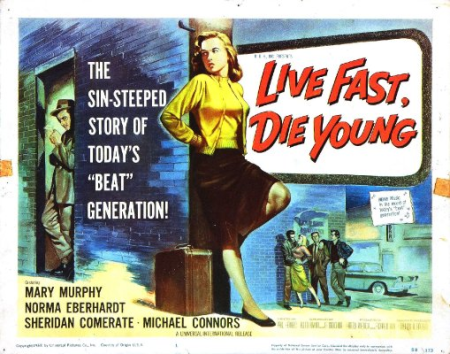
Sigh. This nonsense is promoted by people who are looking at their own youthful days in that generation through rose-

I grew up in the 1950s. I have some nostalgia for the period myself. For instance, I get a kick out of seeing clips on Youtube of old TV shows I remember like Howdy Doody. They bring back some pleasurable memories of fun things and fun times in my own young life… such as this little collection of 4 inch high Howdy Doody puppets I found on the Web recently.
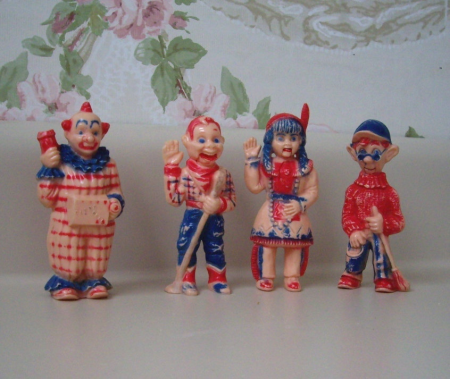
I owned a set just like it, with Clarabell the Clown (originally played by Bob “Captain Kangaroo” Keeshan), Howdy, Princess Summerfall Winterspring, and Dilly Dally, when I was about 7 years old.
Except for Clarabell (who never talked until the last moment of the last episode of the series, when he said, “Good bye, kids”), they each had a little lever in the back of the head that allowed you to “make them talk” just like real ventriloquist puppets. I thought I was SO cool because I owned such amazing toys that looked so much like the real TV characters.
But my nostalgia has nothing to do with thinking that people in general back then, including teens and young adults and older adults, and senior citizens, were so much more wholesome and godly than now. I don’t have rosy glasses that cloud my memories … of kind people, mean people, cheerful people, grumpy people, well-
Life—and the nation of the US—was full of all kinds of people back then, just as it is now.
But perhaps some people are not convinced yet. Of course there were juvenile delinquents, they may say. Enough to cause an “epidemic” of delinquency. But how about adults? See, in the 21st century our society is just reeking with sexual immorality among adults. Just like Sodom and Gomorrah!
Not like the simple, wholesome times of God’s Decade, when almost everybody, except for a tiny minority on the “fringes” of society in ghettos or somethin’, was morally clean and upright. When the divorce rate was low and the family unit solid and stable. When sex was clean and wholesome, kept between a man and his wife.
Jesus, they insist, is absolutely coming back very, very soon because it can’t get much worse than it is now. What a shame we can’t turn our nation back to the ‘50s again.
Yessir. Marital sex was so pure even married couples slept in separate beds! We know that’s true, because we can see it on I Love Lucy reruns!
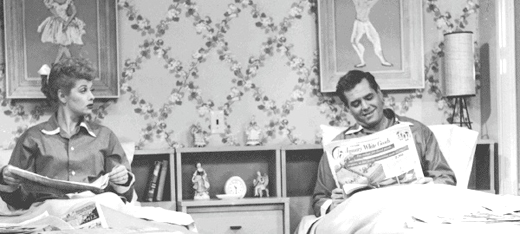
Not a hint of out-
No, what we saw on TV back then and what we can see on re-
And even more “real” … the idyllic marriage of “America’s Favorite TV Couple” was an illusion itself. Although Desi and Lucy reportedly had an honest love for one another of some sort … Desi also had a huge problem with womanizing. (Or its biblical term … serial adultery.) And heavy drinking. Their real-
On March 2, Desi’s birthday, 1960, the day after the last hour-
Let’s be honest … even though marital problems were never shown on the TV shows and reruns of the ‘50s, troubled marriages were just as rampant back then as now. Maybe divorce itself wasn’t quite as prevalent, especially since so few women could “afford” it—even if their husbands were promiscuous philanderers like Desi—because they didn’t work outside the home and would be unable to support themselves if no longer married. But that didn’t stop the philandering, and the emotional turmoil “behind closed doors.”
Extra-
Kinsey estimated that approximately 50% of all married males had some extramarital experience at some time during their married lives. Among the sample, 26% of females had extramarital sex by their forties. [Source]
Although the methodology of the studies may have been a bit flawed, inflating the figures a little, it was still obvious that there was a lot more going on behind those closed doors in their neighborhoods than most people realized.
And then there is the “sexual immorality” issue of pornography. Yes, indeed, there is a real serious problem with pornography on the Internet today, and porn addiction no doubt affects many men. But is this an indication that 21st century men just “naturally” have more of a propensity to be interested in dirty pictures (and videos) now than men in the 1950s? Is the existence of Internet porn evidence of a totally immoral generation unlike any before it? Or is it just a matter of “accessibility”?
I have to wonder … Let’s take a typical male of the 1950s. Call him Joe. What if this man showed up on Joe’s doorstep one day while his wife was off grocery shopping.
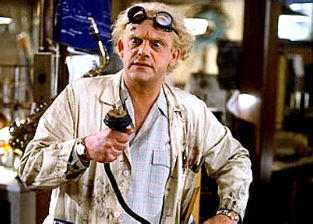
And he explained to Joe he was from the Future.
And he whipped out a Black Box with a screen on the front (like a TV, only much thinner), with a little gadget attached to it by a cord, and put it on Joe’s kitchen table. As he moved the little gadget around the table, suddenly on the screen appeared amazing pictures. Really amazing! “Nekkid women” doing things Joe had never seen nekkid women do in pictures!
And he told Joe that the box contained thousands upon thousands of these pictures. Some of them still photos, some of them “movies.” And he told Joe he COULD, if Joe wanted him to, LEAVE this box with Joe when he went Back to the Future.

What do you think? Would the “moral purity” that Joe absorbed from living in the 1950s impel him to turn his back on the opportunity?
I would suggest to you that the average male of the 1950s didn’t spend as much time looking at porn as those in the 21st century NOT because he was a paragon of virtue—but because he just technologically didn’t have it available to him with the ease and volume available now.
But I would also suggest that whatever was available in the way of porn to men at the time back then…tempted many a man. Were some “good Christian men” impervious to temptation? I do not doubt that! I believe some, maybe many, are today too. That’s the issue I am addressing. YES, there is a lot of filth out there today. But … there was, relatively speaking, a lot available back in what has been alleged to be God’s Decade too. And many men availed themselves of it.
I can remember being about 8 years old, in about 1953, and going to visit my friend Karen at her home a few blocks from mine. Karen’s family was well-
I’m not sure where Karen’s mother was that afternoon. Perhaps out grocery shopping. But she must have been out of the house for a while, because Karen felt bold enough to take me into her parent’s bedroom. There she rummaged around, maybe in a nightstand or chest of drawers—that she’d obviously cased before—and pulled out a box. And when she opened it, I was indeed amazed. It was full of a whole collection of what I came to realize when I got older were likely “dirty French postcards.” There were all these stark nekkid ladies with skimpy “costumes” made out of filmy, totally see-
That was my introduction to the reality that not everyone’s dad was like the paragons of virtue and purity one saw on the TV shows.
And I’m highly suspicious that Karen’s dad was not in the minority among his male friends and neighbors in his interest in nekkid women.
Later in the decade I rummaged in my own parents’ room at about age 12, when they were both out of the house, and by then wasn’t surprised to find that my dad had a little hidden collection of his own: a calendar with those ever-
But see, you never read about these interests of men in the 1950s in history books when they tell about the Presidency of Dwight D Eisenhower, or the first flights into space, or whatever. So the average person born after that time has no way to get their mind around the fact that a whole “other dimension” existed in the idyllic ‘50s.
I’m not quite sure why, though. After all, Hugh Hefner didn’t start Playboy magazine in the Swinging Sixties. The first issue … with a totally nekkid pic of Marilyn Monroe from a 1949 nudie photo shoot as the “center fold” … was published in 1953! And Playboy was just what was “on the surface” of the sexual immorality of the ‘50s. How about behind the scenes?
How about the “Tijuana Bibles”? Right. I never heard of those either until recently.
Tijuana bibles (also known as bluesies, eight-
When they say “well known” they mean it. Caricatures of everyone from Cary Grant and Gandhi to Rita Hayworth, Mae West, Jimmy Durante, Greta Garbo, and Stalin were featured in these little publications. All of them vividly drawn, stark nekkid of course, in the crudest and most explicit of sexual encounters.
I can only imagine how unnerving all that would be to see, but beyond that there were all the folks from the “Funny Papers” involved in equally scandalous activities too! Blondie, Barney Google, Popeye, Dick Tracy, Flash Gordon—yes, even Mickey Mouse and Donald Duck! Here’s a pic of the cover of one from the article on this topic on Wikipedia. It features the burger-
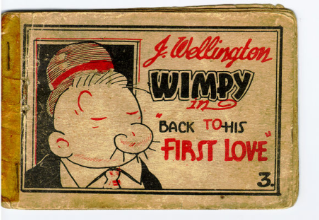
And Here’s a relatively mild cover from 1936 that features the iconic “Fuller Brush Man” door to door salesman of the period.
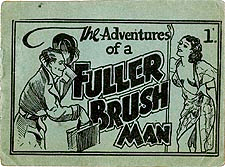
But I can’t emphasize too much just how explicit these sexual escapades were, and often how kinky. Yes, there were boldly-
But surely these had limited distribution, and just among the lowest classes of society?
People distributed Tijuana bibles “under the counter” in places such as schools, garages, cigar stores, burlesque houses, and barber shops as well as from the hatches of station wagons and from persons selling them on the street. The term “Tijuana bibles” refers to the apocryphal belief that they were manufactured and smuggled across the border from Tijuana, Mexico.
The scale on which Tijuana bibles were produced can be gauged from the large hauls announced in police seizures. In one November, 1942 raid by FBI agent P.E. Foxworth and his men on a New York City warehouse and a printing plant in the South Bronx, 8 million bibles were reported seized, and small time businessmen Jacob and David Brotman were arrested along with several associates. According to the FBI four tons of material were ready to ship across the country and 7 tons had gone out recently and were being rounded up at regional distribution centers in Baltimore, Pittsburgh, Cleveland/Akron, and Indianapolis. [Source]
Such raids evidently did little to stem the tide of these grotesque little books, as distribution was still widespread a decade later.
Even though you likely never saw a Tijuana Bible, you may well HAVE seen the artwork of one of the primary artists who created them.

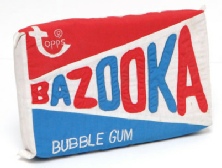
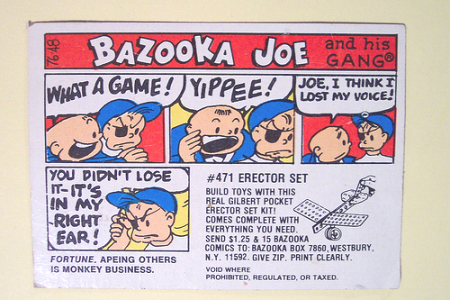
Yes, Bazooka Joe, the Bubblegum Wrapper Icon, and his gang were created by Wesley Morse, who was, prior to his employment with the Topps candy and gum company, famous “behind the scenes” among those in the know as the artist behind many of the steamiest Tijuana Bible editions.
Another unnerving story I read recently about the connection between the cheerful, wholesome “G-
But a nasty fight with the publisher over copyright issues left them in 1948 with a relatively small financial settlement, and fired from any further part in Superman’s future adventures … and money-
Shuster had originally envisioned Superman as a hero for Peace, Justice, and the American way.
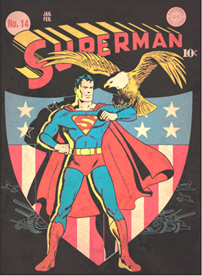
There was always an emphasis in the comics themselves on integrity, morality, and goodness, as seen in this episode of Superboy.
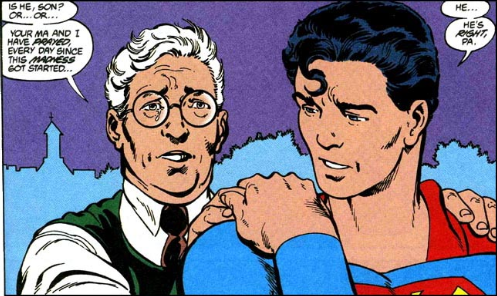
But after losing the copyright battle, Shuster felt he had not received much justice, and became bitter. He tried various outlets for his artistic talent, without much success. It is unfortunate what he finally ended up doing for a while, especially given the noble aspirations of Superman.
Recent research seems to have shown pretty conclusively that Shuster was one of the primary artists for a series of anonymous “underground sadomasochistic fetish comic books” distributed in the early 1950s with the title Nights of Horror. Comic historians note that many of the male characters in the series bear a strong resemblance to Superman, and the females to Lois Lane. It must have been unnerving to see illustrations of a scantily clad clone of Lois Lane in leather, whipping a clone of a bound and chained, naked Superman!
Yes, no doubt some of the hardcore porn on the Internet of the 21st century would make this comic art look tame. But let’s be very clear here … the fact that such abominable trash exists now does NOT tarnish the whole generation of people who exist at the same time. Yes, a subset of people are attracted to and may become addicted to such filth. That is true today … and it was true in the 1950s.
I am not convinced that the “heart” of the average husband of the 1950s who had his private stash of porn—whether Tijuana Bibles, Playboy, nude pin-
But can we set aside the epidemics of polio and juvenile delinquency and smut, segregated drinking fountains, and the threat of nuclear annihilation as just isolated problems, and still assume the Fifties were Fabulous?